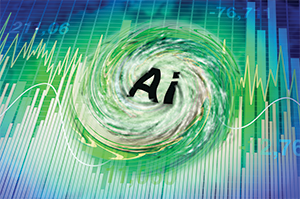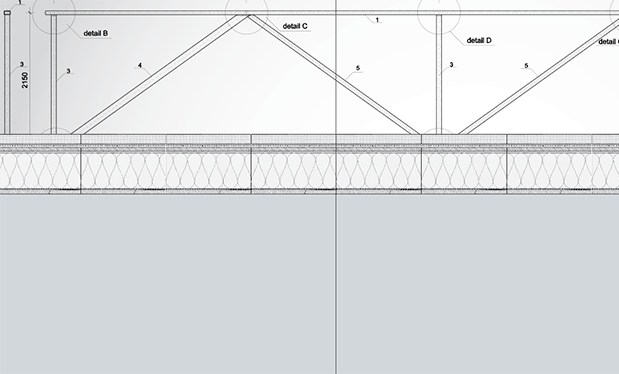AI-based digital hurricane simulations could help improve building codes

|
Researchers at the National Institute of Standards and Technology have devised a new method of digitally simulating hurricanes using 100 years of hurricane data and modern artificial intelligence.
The results of a study published in Artificial Intelligence for the Earth Systems demonstrate the simulations accurately can represent the trajectory and wind speeds of a collection of actual storms. The authors suggest simulating numerous realistic hurricanes can help develop improved building code guidelines for buildings in hurricane-prone regions.
Wind speeds in standardized maps used in building codes are derived from scores of hypothetical hurricanes simulated by computer models, which are based on real-life hurricane records.
Researchers developed current maps by simulating the complex inner workings of hurricanes, which are influenced by physical parameters such as sea surface temperatures and the Earth’s surface roughness. However, necessary data regarding these specific factors is not always readily available.
More than a decade later, advances in AI-based tools and years of additional hurricane records have made possible the new method, which could result in more realistic hurricane wind maps.
NIST postdoctoral researcher Rikhi Bose, NIST mathematical statistician Adam Pintar and NIST fellow Emil Simiu used these new techniques and resources to take a new approach. Rather than having their model mathematically build a storm from the ground up, the researchers taught it to mimic actual hurricane data with machine learning, Pintar says.
With enough quality information to study, machine-learning algorithms can construct models based on patterns they uncover within datasets other methods may miss. Those models can then simulate specific behaviors, such as the wind strength and movement of a hurricane.
Study material used in the new research came from the National Hurricane Center’s Atlantic Hurricane Database, which contains 100-year-old information about hurricanes.
The researchers split data on more than 1,500 storms into sets for training and testing their model. When tested, the model successfully could concurrently simulate the trajectory and wind of historical storms it had not previously seen.
The team also used the model to generate sets of 100 years’ worth of hypothetical storms. It produced the simulations in a matter of seconds, and the authors saw a large degree of overlap with the general behavior of recorded storms, suggesting the model could rapidly produce collections of realistic storms.
However, there were some discrepancies, such as in the Northeastern coastal states. In regions with sparse data, the model generated less realistic storms.
As a next step, the team plans to use simulated hurricanes to develop coastal maps of extreme wind speeds as well as quantify uncertainty in those estimated speeds.
Because the model’s understanding of storms currently is limited to historical data, it cannot simulate the effects climate change will have on future storms. The traditional approach of simulating storms from the ground up is better suited to that task. However, at this time, the authors are confident wind maps based on their model would better reflect reality. Within the next several years, the team aims to produce and propose new maps for inclusion in building codes.
IKO advances asphalt shingle recycling initiatives

|
IKO, Wilmington, Del., has announced the full commissioning of its asphalt shingle recycling line in Hawkesbury, Ontario. The company also recently began the pilot phase of a TPO recycling line in its Hagerstown, Md., plant that opened in 2022.
The Hawkesbury location, one of IKO’s eight modern shingle manufacturing plants, is among the first shingle plants to graduate from a pilot phase into daily production. Planning for the two-story, 28,000-square-foot recycled asphalt shingles facility began in late 2019, and the plant became fully operational during the winter of 2022-23.
“IKO is among the first asphalt shingle manufacturers in North America to achieve true circularity at one of its shingle plant locations with an in-line waste recycling process,” says Dan Horton, founding partner of ASR Systems, and IKO’s partner in the initiative.
A typical shingle recycling plant produces about 5,000 tons of recycled content per year—a small percentage of the raw materials used annually by an average production facility. IKO expects its facility will be able to recycle up to 150 tons of shingle material per day when it reaches capacity later this year.
“The first significant step toward reducing shingle related disposal in landfills is our goal to achieve zero percent waste at every plant location,” says David Koschitzky, IKO’s CEO. “We are well on our way to achieve this objective at our Hawkesbury facility, and we will use what we learned from this effort to rapidly innovate even more efficient lines at IKO Hagerstown and each of our shingle plants in the coming years.”
Workers report construction is behind on technology use

|
The 2023 Technology in the Workplace survey from Coppell, Texas-based software developer Yooz was released April 26 and shows the construction industry is viewed as “the least technologically competent” by workers, according to Construction Dive.
Construction ranked last of 10 surveyed sectors, with the software and health care industries ranking No. 1 and No. 2, respectively. Additional industry rankings were logistics/supply chain/transportation at No. 3; banking/finance at No. 4; manufacturing at No. 5; insurance at No. 6; hospitality/travel at No. 7; automotive at No. 8; and restaurants at No. 9.
The report surveyed 600 U.S. professionals with a minimum salary of $50,000 who worked in those 10 fields. Sixty-four percent of all participants said they spent more than half their workday using workplace technologies, and 37% said they spent more than three-quarters of their day using them.
Younger professionals especially view technology adoption as a crucial aspect of career advancement. Fifty percent of workers younger than 25 in all industries said they either agreed or strongly agreed when asked: “To what extent do you agree or disagree with the statement: The way my industry views adopting new technology is a barrier to my career advancement.” Thirty percent of workers 25 and older gave the same response.
Workers also value training. Only 20% of survey participants said their IT departments trained them, and 4% said responsibility fell to their human resources department. A majority said they taught themselves or received informal instruction from peers or online services.
Survey respondents reported the significance of technologies such as cloud computing and automation, and nearly a quarter of respondents said artificial intelligence would have the largest effect on industries if adopted.



